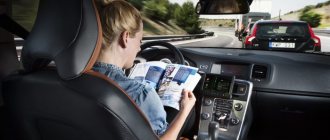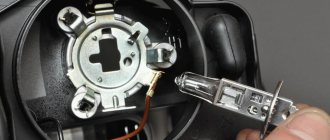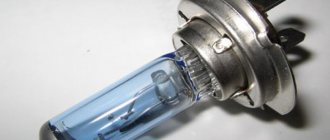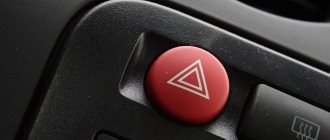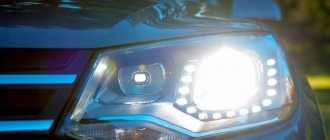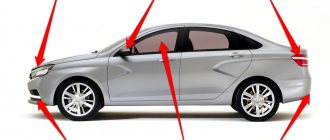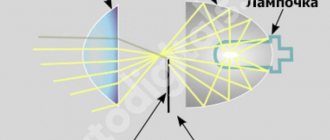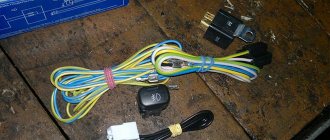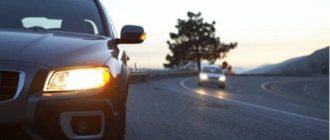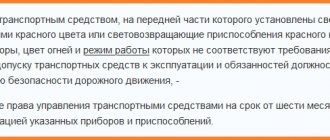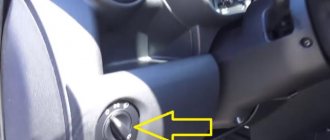The timing of turning on a car's headlights is not a driver's whim, but a clearly stated point in the traffic rules. A special section describes all the conditions in which you need to light the running lights, high and low beams and fog lights. We will tell you what headlights should be on during the day and what the driver needs to know to avoid controversial issues on the road.
Changing something good only spoils it
“Now the old rules continue to apply; no new amendments to the traffic rules regarding lighting devices have been adopted,” says Pyotr Shkumatov. But there is one point hidden in the traffic rules, around which the controversy began.
The fact is that the latest amendments to paragraph 19.5 of the traffic rules were approved in 2010. They have significantly tightened the rules for the use of lighting devices on vehicles. If previously passenger cars were required to drive during the day with lights only outside the city, then in the new edition of the traffic rules this has become mandatory within populated areas. Meanwhile, 8 years ago there was some relaxation. It was allowed to use daytime running lights instead of low beam headlights. The literally edited clause 19.5 of the traffic rules read: “During daylight hours, low-beam headlights or daytime running lights must be turned on on all moving vehicles for the purpose of identifying them.”
Apparently, the addition “or daytime running lights” has caused so many discrepancies and interpretations. Some drivers thought that instead of bright low beams during the day, they could limit themselves to dim headlights. What does this lead to?
Is it possible to cut a turn through a solid road and how to avoid deprivation of rights? More details
This is interesting: How to bleed the clutch on a Ford Focus 1
Turning on car headlights according to traffic regulations
Motorists are rightly interested in when and which of the headlights, including low and high beams, they are or are not required to turn on, based on the current traffic rules.
A lot here depends on the time of day, although people are often asked about what to do correctly in the city and beyond.
Let's start with urban conditions. If you look at section 19 of the current Rules for driving on public roads, there are no significant differences between the use of optics in the city and outside the city. Based on this, it is possible to determine when and which headlights the driver must turn on without violating traffic rules.
How to act during the day
Even before February 2010, the rules were significantly different from the current ones. Now those standards do not apply. But then drivers were required to use low-beam headlights when driving outside populated areas and in the city, but only under certain conditions. These special conditions included transporting children in large groups, moving cars in convoys, etc. But then the rules changed. The most current version is the amendment dated May 2018.
Current laws state that low-beam or daytime running lights must be turned on during the day on all vehicles. And regardless of location. This rule applies within the city and beyond.
Although it is important to add one nuance here. Small concessions were made to drivers. If the car is moving within the city or outside it, then you can turn on the fog lights without the mandatory parallel use of low beam.
Light and sound devices of the car and their location
We should start with the basics, or rather with what types of headlights and lanterns modern cars are equipped with.
- Low beam headlights - designed to illuminate the road and surrounding area in a relatively small area.
- High beam headlights are powerful lighting devices that illuminate the roadway over a fairly large area. Due to its high brightness, high beams can blind oncoming drivers.
- Front fog lights - installed lower than conventional headlights, create a wide beam of light that well illuminates the road and the surrounding area in conditions of fog, snowfall and rain.
- Daytime running lights are a separate type of headlights that are turned on during the day, regardless of weather or visibility, and are designed to increase the visibility of vehicles. Most models turn on immediately when the engine starts.
- Tail lights - designed to identify the vehicle at night or in poor visibility conditions. The color of the lamps is red.
- Brake lights are red lights that come on when a vehicle slows down. They burn much brighter than the side lights. Some cars are additionally equipped with a central brake light.
- Rear fog lights - indicate the vehicle in fog, rain or snowstorm conditions. Not to be confused with brake lights.
- Reversing lights are white and are designed to inform pedestrians and other motorists that the vehicle will be moving (or is already moving) in reverse.
- Rear reflectors - used for the same purpose as side lights, they reflect the light falling on them from the headlights of passing cars. May also be known as retroreflectors.
- License plate lighting – several white bulbs designed to illuminate the rear license plate of a vehicle.
- Turn signals, or “turn signals,” are amber lights that are used to inform you that the vehicle is turning or otherwise maneuvering. Installed in the corners and on the sides of the car.
Lighting control
Please adhere to the appropriate traffic regulations when using lighting devices.
When driving a vehicle on a rainy day, the window glass will quickly cool down and the temperature of the glass inside the vehicle will quickly decrease, so the moisture remaining in the air will accumulate and create condensation. In this case, water will appear on the inside of the window glass. The reason for the appearance of condensation on the inner surface of the headlight glass is the same. In other words, the amount of water in the air will increase as the temperature rises and if the temperature drops, the water will accumulate and create condensation known as fog.
If condensation appears on the light fittings of a vehicle, then after turning on the high and low beams, the condensation that appears on the glass of the headlights will begin to dissipate and disappear after 1 hour - this is normal. If not, there may be water inside. Contact the appropriate service station for repairs.
When replacing a light bulb, carefully check the installation of each part of the light bulb to ensure proper installation and good insulation! Otherwise, serious consequences may occur due to water or dust getting inside!
High pressure water jets should not be used to clean the engine compartment, especially the light fittings. Otherwise, due to the high jet pressure, parts of the light fittings may become loose and come off, and the vent, wiring and electrical connectors may become wet.
As a result, the water that will be inside the light fittings or steam will not dissipate, which will lead to the creation of a large amount of condensate.
parking lights
Turn the outer ring of the steering column switch lever 1 to a position where mark 2 aligns with the corresponding symbol.
Low beam headlight
Turn the outer ring of the steering column switch lever 1 to a position where mark 2 aligns with the corresponding symbol. The corresponding warning light on the instrument panel will light up.
High beam headlight
If the low beam is already on, then to turn on the high beam, pull the lever of the steering column switch 1 towards you. The corresponding warning light on the instrument panel will light up.
To turn on the low beam headlights again, move the switch lever toward you again.
Fog lights
Please note that if it is necessary to turn on the fog lights, the side lamps and low beam headlights must be turned on. Typically, the front fog lights are turned on in case of fog, snowstorm, rain, or when visibility is severely limited.
Turn the middle ring 3 of the steering column switch lever to a position where mark 4 aligns with the corresponding symbol.
The fog lights turn on only if the exterior lighting is already on. When turned on, the corresponding lamp on the panel lights up.
Remember to turn off your fog lights when they are not needed to avoid disturbing other drivers.
Rear fog light
Turn the middle ring 3 of the steering column switch lever to a position where mark 4 aligns with the corresponding symbol.
Turning off the outside lights
Set the outer ring of the steering column switch lever 1 or 3 to its original position.
When can a driver be punished with a fine, and is this possible?
To avoid a fine for improper use of lighting devices, the driver must drive with headlights on at any time of the day .
If this condition is not met, he will be punished with a fine. In addition, if the rules for operating a car are violated in the event of an accident, both participants will be found guilty. Even if only one person breaks the rules. The reason for making such a decision may be a faulty headlight. You can be fined for improper use of low beam headlights for various reasons. The most common situations for which you may be fined are described below
- Use in populated areas with high beams.
- Incorrect use of rear fog lights.
- Use of running lights in the evening.
- The low beam is not on during the day.
And now about everything in more detail:
- Use in populated areas with high beams. When entering a populated area or a well-lit road, the driver must switch from high beam headlights to low beam. Otherwise, a fine will be imposed on him.
- Incorrect use of rear fog lights. They are additional lighting devices that can only be used in low visibility conditions. In any other case, this will be considered an offense with further sanctions.
- The use of running lights in the evening. In cars equipped with running lights, low beams must be turned on in the dark. In this case, daytime running lights must be installed in accordance with all GOST requirements. In this case, we are talking about their territorial location. The characteristics of light are also taken into account. The correct placement of headlights of this type can provide high-quality illumination of the road and will not dazzle oncoming drivers.
- The low beam is turned off during the daytime. Most drivers, when driving during the day, forget about the need to turn on their low beam headlights. Some models are equipped with an electronic control system that automatically turns on the lights when the car is started.
Automation options
It is quite possible to install an automatic switch and switch that will be responsible for the low beam with your own hands. But first you need to decide which method of implementing the scheme suits you best than the others.
There are 3 current options available:
- switching on when ignition is activated;
- Automatic switching on of the optics after starting the engine;
- using a special light sensor.
Each low beam automation scheme can be implemented in a garage. But if you do not have the necessary skills, doubt your capabilities, or simply want to get a guaranteed result, seek help from specialists.
Light sensor
On many foreign-made cars, the factory equipment already includes a special device that automatically turns the car's optics on and off. They work in tandem with a light sensor.
The device responds to changes in lighting levels. If the sensor detects darkening, the headlights turn on. When the car is on a bright section of the road, it automatically turns off. In many countries this function is very useful and convenient. But not quite suitable for the Russian Federation.
It's all about the requirement to constantly, day and night, drive with low beams or daytime running lights on. Therefore, in this situation, the operation of the sensor has to be adjusted.
Turning the low beam on and off should become a habit for drivers in the absence of an automation system. If you forget about the lighting before you start driving, you may be fined. If the automatic shutdown does not work or is simply absent, the turned on headlights on a parked car will drain the battery by the morning.
Drivers who cannot train themselves to turn lights on and off as needed are best off using an automation tool. One of them is considered a special sensor.
Motorists are offered the option of making the device themselves, or purchasing a branded device. Here we definitely need to stick to the second option. The following recognized companies offer automatic headlight switching and switching devices:
Most devices are based on a light sensor. And this, as you already remember, does not comply with the traffic rules in force in the Russian Federation. This is not a problem, since some devices are reconfigurable, allowing you to adapt them to slightly different work.
Light sensor
There is no need to describe in detail the nuances of installing a device with a light sensor. Each manufacturer completes its products with detailed instructions. They may differ from each other in the installation method. But in reality there is nothing complicated here.
Experienced drivers advise installing the light sensor not outside, but towards the interior, in the area of the rear view mirror, where it is usually located on cars with factory-made sensors.
Among the options presented, installing a sensor is considered the least practical and rational way to automate the switching on and off of optics. Yes, in certain situations the device greatly simplifies driving, since the driver does not have to be distracted by switches.
What color of side lights is allowed according to traffic regulations?
If the color of the light device does not meet the standard requirements established for the type of vehicle, the traffic regulations prohibit the operation of such a vehicle.
Requirements for external lighting of vehicles are established by GOST 8769-75. The terms of the standard determine that the front dimensions must emit a white color, and the rear dimensions must emit a red color (Clause 2.5.6).
Requirements for the color of side markers are established by GOST R 41.91-99: it must be yellow.
This is interesting: How to change the low beam bulb on a viburnum 1
Using dimensions
Also, all cars from the factory are equipped with side lights. Unlike PTFs, they are present on all cars and are not additional elements of lighting devices.
Dimensions are special compartments with low power lamps. They are located front and back. The main function is to signal that the vehicle has stopped in the dark or when there is too much visibility on the road.
It's safe to say that the dimensions are designed to ensure safety. Their glow allows other drivers to understand that this car has stopped.
Traffic regulations have specific rules regarding how and when to use these vehicle lighting elements.
- Dimensions include if the vehicle stops (less than 5 minutes) or parks (more than 5 minutes) in the dark, in fog, at twilight, during heavy rain or snowfall.
- If there is heavy fog, snow or other unfavorable conditions outside, the driver may, but is not required to, turn on other lighting devices in addition to the side lights. Among them are low-beam headlights, rear and front PTFs.
- If the driver violates the established requirements, he faces a fine, as for similar offenses related to the improper use of automobile lighting devices.
Can you be fined for a non-working headlight?
If for some reason one of the low beam headlights in a car does not light up, this may also result in a fine . However, the interpretation of such a situation may differ slightly from the case described above. In this case, the driver did not violate the rules for operating lighting devices. A violation here is considered to be a malfunction of the headlight, as well as conditions prohibiting the operation of the car.
In case of technical malfunctions due to which the low beam is turned off, according to Article 12.5 of the Code of Administrative Offenses, Part 1, the violator will be punished with a fine of 500 rubles in connection with a non-working or dirty lighting device . In addition, pay attention to clause 2.3.1. Traffic regulations, which state that driving with faulty or missing lighting devices at night or in low visibility can be considered an offense.
Possible causes of malfunction
So, if the low beam in one of the headlights of a Lada Kalina does not light up, then the reason most likely lies in a burnt-out light bulb.
Replacing it will not be difficult for every car owner. However, unfortunately, there are a number of other reasons for this malfunction, the most common of which are the following:
- The contacts in the plug block are oxidized or burnt;
- The fuse has blown;
- Open circuit;
- The relay has failed.
Below we will look at how to fix all these problems.
H7 standard bulb
Replacing the lamp
Replacing the low beam on Kalina is quite simple. Moreover, you will only have to spend a few minutes of your time on this.
The only thing is that before replacing old lamps, you need to purchase new ones of the H7 standard. It is advisable to install new bulbs on two headlights at once so that they provide the same glow.
Removing the plug
Replacement instructions are as follows:
- First of all, you need to remove the rubber plug located on the back of the headlight. To do this, you must first open the hood.
- Then you need to remove the positive and negative terminals from the contacts.
Releasing the latch from the landing
- Next, you need to press the spring bracket with your own hands and remove it from the seat.
- After this, you need to remove the old light bulb and put a new one in its place.
- Then you need to replace the bracket, put the terminals on the contacts and install the plug.
When replacing light bulbs, you need to pay attention to the quality of the contacts. If the contacts are oxidized or burnt, they must be cleaned. Fuse and relay block Lada Kalina
Fuse and relay block Lada Kalina
Replacing the fuse
If, after replacing the lamps, the low beam headlights in the Lada Kalina still do not work, you should check the fuses. They are located in the mounting block under the steering wheel.
The lamps are protected by different fuses:
- Right lamp – F12
- Left lamp – F13
It must be said that it is not always possible to visually identify a blown fuse. Therefore, even if it has no external defects, you should check the voltage at the terminals with a test lamp or multimeter.
Lada exterior lighting diagram
Open circuit
If the fault cannot be eliminated, then you need to find an open circuit.
You can do this as follows:
- If there is no voltage at the fuse terminals, you need to ring the wire that goes from F13 to contact No. 56 of the lighting control unit, since you can turn on the low beam headlights on Kalina using switch No. 5.
- If the wire is intact, but 2 headlights do not light, then switch No. 56 must be replaced. However, you should first check whether voltage is supplied to the switch itself.
- If voltage is supplied to fuses F13 and F12, you should check whether there is voltage at the relay output. Let us remind you that the low beam relay in the Lada Kalina is located in the mounting block.
- If there is no voltage, you should check the area from F12 to contact No. 56 of switch No. 4, which is located on the steering wheel, as well as the area from terminal No. 56a to terminal 1 of relay K7. It is also quite possible that switch No. 4 or the relay itself is not working.
Replacing the latter is not difficult, since it is simply inserted with contacts into the socket.
In the photo - lighting relay Lada Kalina
In cases where there is voltage at the relay output, you should check the wiring of the machine from the mounting block to the headlights according to the diagram.
As we can see, finding an open circuit or a faulty part is not difficult. To do this, you only need a low beam circuit on Kalina and a multimeter or test light. These are, perhaps, all the main reasons for this malfunction on the Lada Kalina car.
Pros of using DRL
The advantages of using DRLs can be considered using two examples:
- Most cars in use have fairly high power and torque. All this allows them to quickly accelerate to high speeds and perform various maneuvers. If, while one car is performing a dangerous maneuver, the other driver does not notice the vehicle coming towards you, an accident may occur.
- It seems that during the day in the sunshine the car is clearly visible. But the glare from the windows and mirrors of cars coming towards you dulls visibility. In this case, DRL can protect you from an accident.
Design and principle of operation of the Light Assist high beam control system
Light Assist is an automatic high beam control system (high beam assistant). This assistance system increases safety and helps the driver when driving at night. The essence of its work is to automatically switch the high beam to the low beam. We will tell you more about the device and operating features in the article.
Purpose of Light Assist
The system is designed to improve illumination at night. This task is achieved by automatically switching the high beam. The driver drives with the high beam switched on as far as possible. If there is a risk of dazzling other drivers, Auto Light Assist will switch to low beam or change the angle of the light beam.
How Light Assist works
The operating conditions of the complex will depend on the type of headlights installed. If the headlights are halogen, then automatic switching occurs between low and high beam depending on the situation on the road. With xenon headlights, the reflective element in the headlight automatically rotates in different planes, changing the direction of the light. This system is called Dynamic Light Assistant.
The main components of the device are:
- Control block;
- interior lighting mode switch;
- black and white video camera;
- headlight module (reflective element);
- light sensors;
- dynamic control sensors (wheel speed).
To activate the system, you must first turn on the low beam, then switch the switch to automatic mode.
The black and white video camera and control unit are located in the rearview mirror. The camera analyzes the road situation in front of the car at a distance of up to 1,000 meters. It recognizes light sources and then transmits graphic information to the control unit. This means that the source (an oncoming vehicle) is recognized before it is blinded. The length of the high beam light beam usually does not exceed 300-400 meters. The high beam automatically turns off when an oncoming vehicle enters this area.
When to turn it on and off
All cars have different design solutions for external lighting.
To move on to using the dimensions, you need to clearly know how they turn on and where the controls for these devices are located. This information is detailed in the vehicle's owner's manual.
Sometimes they simply forget about including dimensions. In older cars, this option was turned on simultaneously with the backlight; it was technically impossible to forget.
In modern vehicles, everything is separate: both lighting and dimensions. Turning the optics on and off in certain situations needs to be controlled.
Clause 19.3 of the traffic rules provides for the driver’s obligation to turn on the side lights in the following cases:
- When stopping (parking) at night on unlit road sections.
- In conditions of poor visibility. Additionally, simultaneous activation of daytime running lights, low beam headlights, and fog lights (headlights and rear lights) is allowed.
A significant decrease in visibility occurs under the following conditions:
- in heavy fog;
- at night and at dusk;
- during precipitation, snow or rain;
- when driving in a tunnel.
In conditions of limited visibility when stopping and parking, the driver is given the right to independently decide how to make the car more visible, which lighting devices need to be turned on additionally.
At the same time, we must not forget: even in difficult weather conditions, the choice of a place to stop and park is regulated by the Traffic Rules.
It is believed that movement is most difficult in the dark and in heavy fog. Don't wait until the fog makes the road indistinguishable.
It is better to turn on the lights even in light fog.
When stopping at night on the side of the road, to improve visibility, in addition to the side lights, you should turn on the hazard warning lights.
It’s better to make a rule for yourself: if it becomes worse to see, you need to turn on the dimensions. Do not forget that all drivers have different vision. It is really necessary to indicate the dimensions of the car, because in the dark a car without dimensions is just a ghost.
And also, practical advice: if the low beam of the headlights becomes visible on the road, it’s time to use the side lights.
Methods for connecting fog lights
Connecting PTF can be done in several ways. The simplest one is if the car is equipped with fog lights from the factory, that is, the electrical circuit consists of all the necessary components: connectors, switch, connecting wires, fuse, relay.
Installation, in this case, consists of installing the headlights and connecting them to the power supply. This method can be used when the car is fully equipped, if you need to replace installed fog lights or to improve the lighting system.
If the basic configuration of the car does not include foglights, you will have to install the wiring yourself. To do this, you need to purchase the necessary components: a set of wires, a relay, a switch, etc. You can purchase a ready-made kit for installing fog lights. Know how fog lights are included in a car's electrical circuit (video author: Morgan One).
Some drivers doubt whether it is possible to connect fog lights to headlights. This cannot be done, since the switch and wiring in the side lights are not designed for the current consumed by the headlights.
Having purchased a universal kit for connecting fog lights, you can connect the fog lights yourself using the following algorithm:
Laying the wires must begin by dismantling the dashboard and connecting the relay. First you need to find the wire going to the instrument lighting. Following these wires, you can find a block that has a free connector to connect the fog light relay into. The second step is to connect the switch. If there is a free button on the dashboard, connect the headlights to it. If there is a free button, then you need to install a new one. The next step is to connect the relay to the battery. The wire from the battery must be connected to pin 87 of the relay
It is more convenient to run the wire under the pedals. It is important to include a fuse in the electrical circuit when installing. This will protect the lamps from burning out and will save you from a fire in the event of a short circuit
The fuse rating is calculated based on the power of the headlights. If you take 60 W bulbs, then the current to power the headlights will be: 2 * 60 W / 12 V = 10 A. The fuse must be selected with a high rating. In this case, it is necessary to use a fuse with a rating of 15 A. Now we mount the PTF in the bumper. Before installing the fog lights, you need to mark the locations for the headlights according to the requirements. It is better to install PTF on a removed bumper. After installation, the headlights must be securely fixed using the fasteners that come with the mounting kit. The negative wire must be shorted to ground (car body), the positive wire must be connected to the 30th contact of the relay. At the final stage, the relay is installed in its seat and secured. The instrument panel returns to its original location.
Photo gallery
1. PTF installation kit
2. Set of wires for connection
3. The process of pulling the wire to connect
4. Installation of the power button After installing the PTFs, you need to check their operation and adjust them. If your headlights are raised too much, they will lose their effectiveness when driving in bad weather conditions.
DRL installation rules
The traffic rules give a clear indication of how daytime running lights should be installed:
- DRLs must be installed at the front of the vehicle.
- The distance from them to the ground should not be less than 25 centimeters and more than 1.5 meters.
- DRLs must be located at a distance of at least 60 cm from each other.
- The distance from the body edge to the DRL should not be more than 400 mm.
If there are no DRLs, the driver has the right to install them. Today there is a huge selection on sale. There are lights with LED lamps, with conventional incandescent lamps. LED lights are the most popular because they are very economical in terms of energy consumption.
Nuances of using PTF
There is a lot of talk about PTF among motorists, since not everyone has them. Everyone is trying to understand when it is possible and necessary to turn on fog lights on a car.
Clause 19.4 of the current Traffic Rules will help you understand this issue. According to this document, the presented type of optics can be used in difficult weather conditions that cause difficulty in visibility.
Drivers have the right to turn on the PTF on their car, using them in conjunction with low and high lights or with clearance lights.
Taking into account the new amendments to the law on low beams and DRLs, PTFs are now equated to these vehicle lighting devices. Therefore, drivers are allowed to legally use PTF as an independent lighting element during the daytime. There is no penalty for such actions, and this is a completely legal action.
All this makes it possible to use both low beam and DRL during the day, that is, daytime running lights, or fog lights that are not always provided from the factory.
We must not forget that PTFs are an additional element of optics on vehicles. Not all cars are equipped with such devices. Their absence and non-use is not punishable by any fines. If your car doesn’t have PTFs, you can drive without them. But if you have fog lights, you must comply with traffic regulations.
What do the traffic regulations say about running lights?
According to the 2016 Road Traffic Regulations, all drivers must turn on DRLs or fog lights or low beam lights while driving. Such requirements ensure the safety of all other road users.
If the driver does not comply with this rule, he may be issued a fine of 500 rubles.
According to the traffic rules, DRLs must be used in the following cases:
- If minor passengers are transported;
- If transport is difficult to distinguish in the distance;
- If oversized items or harmful substances are transported;
- DRLs must be used on public transport and minibuses.
Flashing on the highway
Another common occurrence of high beam flashing is what is known as a rear-end collision.
On high-speed roads, there are often situations when a car pulls up behind you and the driver uses the high beams to demand that you give way. Often, reckless drivers try to scare the slow-moving vehicle that is “interfering” with them and imitate an emergency situation by approaching too close to the bumper and moving to the left, literally to the bump stop itself, indicating that they need to pass. Such maneuvers irritate other road users, as they can provoke a real accident.
In Germany, if a violator is caught in “pressure from behind”, he faces a fine in the amount of his monthly salary. If the violation is repeated, the traffic police may issue a driving ban for up to six months plus two penalty points for your personal record. If you accumulate 10 points, you risk having your driver's license revoked.
In Russia, any “rear-end collision” with blinking headlights is also considered dangerous driving. Paragraph 2.7 of the traffic rules states that the driver is prohibited from dangerous driving, expressed in repeated changes of lanes or lanes, as well as “failure to maintain a safe distance from the vehicle in front, failure to maintain a lateral interval, sudden braking,” etc.
In other words, failure to maintain a distance is already considered provoking an accident, as is arbitrary sharp braking of a slow-moving vehicle in order to punish the reckless driver. Therefore, the person overtaking and being overtaken on a multi-lane road should refrain from sudden actions.
True, the punishment for dangerous driving has not yet been approved in the Code of Administrative Offenses of the Russian Federation; traffic police inspectors can only issue a verbal warning for such maneuvers. Although, as a rule, there is always an article for the violator under which he is punished, including for violating the speed limit or improper use of lighting devices. It is forbidden to shine high beams from behind to avoid dazzling through the rear view mirrors.
As a rule, reckless drivers are clearly visible from afar thanks to the light signals they give to other road users.
When and how should the fog lights, low and high beam headlights be turned on? More details
How to choose DRL?
The requirements that must be taken into account when installing DRLs have already been described above.
If the running lights on your car are not installed correctly, the traffic police inspector will have the right to stop you and issue you a fine. In some situations, the vehicle may even be sent to an impound lot.
If you want your running lights to comply with traffic rules and GOST, you should pay special attention to their selection. After all, a lot will depend on what kind of road running light you decide to install on your car. The highest quality products are produced by companies such as Hella and Philips Osram. It is worth choosing them not only because they meet all the standards, but also because they can make your journey on the roads as safe as possible. There are usually no problems with the products of the brands presented above when the car is diagnosed at a service station. Homemade devices cannot meet all requirements.
Usually there are no difficulties with installing DRLs. The only thing that can cause you inconvenience is a violation of the integrity of the car’s structure. This problem is most common among drivers who bought their car before the law on the mandatory use of DRLs came into force.
If you have an old car that does not have DRLs, then you will have to collect a lot of paperwork to obtain permission to make changes to the vehicle. In addition, you will also have to put in a lot of effort to install running lights. After all, to do this you will have to create holes in the bumper and deal with the electronics.
Hotlines:
Moscow:
+7, ext. 206 St. Petersburg: +7, ext. 997 Regions of the Russian Federation: +7, ext.
669 .
Applications are accepted around the clock, every day. Or use the online form.
Possible penalties
If we start from section 19 of the current Traffic Rules, then if any of the requirements stipulated in the document are violated, liability arises. It is determined based on Article 12.20 of the Administrative Code.
This article has 2 possible sanctions:
- warning;
- money penalty.
The decision is made at the discretion of the inspector who recorded the offense. In this case, the fine is 500 rubles.
The driver will be given a warning or fine if:
- he drives at night only in PTF;
- did not switch from high to low when an oncoming car approached at a distance of less than 150 meters;
- PTF or low beam headlights were not turned on during the day;
- rear fog lights are used in different conditions, except poor visibility, etc.
The inspector determines which sanction should be used against the offender. The department employee relies on the presence of aggravating or mitigating circumstances, which is also provided for by law.
When imposing a monetary fine, the violator has the right to pay only half the amount, thereby receiving a 50% discount. This is possible if, after the decision is made, the fine is repaid within 20 days.
It should be added that such sanctions apply only to the improper use of vehicle lighting devices, which fully comply with all requirements and standards. If the headlights do not meet technical standards, then much more serious penalties are provided.
Let's give a simple example. The headlights are a color other than white, yellow or orange. The driver installed films or used paint, which made the light red. For such a violation, deprivation of rights for a period of 6-12 months is possible. Additionally, the inspector undertakes to seize lighting devices that do not meet the established requirements.
What devices are used at night?
It would be more correct, of course, to say “in the dark,” which is even defined in the traffic rules. Without going into too much detail, it’s just a time when it’s dark, at dusk in the morning or evening and at night.
Here headlights are used in high and low beam modes. If you are parked overnight (or if you are driving with a trailer, or are towed), then you need to switch to dimensions. In this case, the fog lights should not work separately; they are accompanied by high beam or low beam.
If you have a spotlight, do not use it if you are driving through a populated area or when you see an oncoming car. This is a traffic violation.
The rules establish a procedure that ensures the safety of all road users. Therefore, it is not allowed to blind oncoming drivers with high beams if the cars have approached more than 150 m. In addition, the oncoming driver may ask you to switch the mode of the lighting devices. This is usually done by “blinking” the headlights.
When moving around the territory of a well-lit populated area, they also do not use high beams. And, as in the situation with daytime mode, it is prohibited to use fog lights on a lit road without accompanying low or high beams. DRLs are also not turned on at night.
For movement through tunnels day and night, all of the above requirements apply.
Rules for using lighting devices
The rules for using headlights and flashlights in various situations are discussed in detail above, but remembering them is not so easy. Therefore, we will consider them in a more compact form.
- use the rear fog lamp when visibility is good;
- use high beams in populated areas on illuminated roads, when passing oncoming traffic, when blinding passing or oncoming drivers;
- do not use low or high beams at night, with insufficient visibility, in a tunnel;
- do not use DRLs, low beams or PTF during the day;
- Do not use clearance when parking in poor visibility conditions or on an unlit section of the road at night.
All other options and combinations of lighting devices are not a violation.
In conclusion, let me remind you that fines for improper use of lighting devices are discussed in a separate article:
Features of using standard daytime running lights
The design of the vehicle may not provide daytime running lights on all models .
As for installing them yourself, this can also lead to a fine. And even if such design changes are not identified during an inspection by a traffic police instructor, they will be discovered during a routine technical inspection. To ensure that these actions are not regarded as an offense, the driver will first need to obtain appropriate permission from the authorities to install daytime running lights. Those car models that are designed with daytime running lights can drive without fear that they will be fined. In addition, the standard lighting system is characterized by a different operating mode - they automatically turn on when the engine starts . When low-beam headlights are activated, the standard daytime running lights contribute to a reduction in power and are used as additional dimensions.
Please note that if the standard daytime running lights are on, you cannot be fined for driving with the lights off.
How to automatically turn on low beam headlights on a car with your own hands
Lighting equipment, that is, headlights, plays a vital role in the operation of a vehicle. With the help of optics, you can not only illuminate the road surface at night. Headlights also serve as an identification sign for other road users when visibility is poor.
If a driver drives with his headlights on, oncoming cars at a sufficiently large distance will be able to notice this. This allows you to prevent accidents, accidents, erroneous maneuvers and other unpleasant situations on the roads.
According to traffic regulations, drivers are required to turn on low beams not only in the evening and at night, but also during the day. If the headlights do not work, this will be a strong argument for issuing a fine to the motorist.
Threats of a fine, as well as the issue of real safety, force drivers to look for convenient solutions to automate the process of turning on and off the low beam. There are several implementation methods, each of which has its own nuances, strengths and weaknesses.
The car owner has the right to choose how to automatically turn on the low beam headlights with his own hands.
Stopping and parking a car
At night on an unlit road
Must be included:
- parking lights.
It is prohibited to use:
- fog lamp.
Other lighting devices can be used.
In case of insufficient visibility (during dark or daylight)
Must be included:
- parking lights.
Other lights, including the rear fog lamp, may be used.
Driving in the dark
One of the following lighting fixtures must be used:
- low beam headlights;
- high beam headlights.
In this case, the main beam cannot be used:
- in populated areas on illuminated roads;
- when oncoming vehicles pass;
- when blinding drivers of passing or oncoming cars.
Additionally you can use:
- fog lights;
- fog lamp (only in case of poor visibility);
- parking lights.
Hazard lights: what they are for and when to turn them on
The so-called “emergency light” is also a combination of the operation of several lighting devices, and therefore belongs to the section in the traffic regulations that regulates the use of various modes of operation of car headlights. What should you consider when activating the emergency alarm mode?
The very first thing is, of course, emergency situations in which not only emergency lights are involved, but also an emergency stop sign. The latter must always be in your trunk, otherwise you will violate traffic rules. Regardless of where the emergency breakdown of your car occurred, in a vacant lot or on the highway, you need to protect yourself and other road users by marking your car in accordance with the traffic rules. A warning triangle is installed on the route to your car 15 or 30 meters from it, depending on the location of the breakdown.
How to turn off the high beams on a Ford Fusion?
To switch between low and high beam headlights, pull the steering column stalk all the way towards the steering wheel.
How to turn on fog lights on a Ford Fusion?
To turn on the front fog lights, disable the automatic lighting control function. Turn on headlights 1 and pull switch 2 out one position. Front fog lights should only be used in conditions of limited visibility (due to fog, snow or rain).
How to turn on high beam on a Ford Mondeo?
To signal with high beam headlights, pull the left steering column switch towards you without bringing it to a fixed position. The high beam remains on when the lever is held, and when released, the lever returns to its initial position.
How to turn off the high beams?
The high beam can be turned on when the steering column stalk is in the or position. To activate the high beams, move the steering column stalk forward. To disengage, move the steering column lever rearward.
How to turn on low beam headlights on a Ford Fusion?
You need to lift the lever up. The lever must be pulled down. You need to pull the lever towards the steering wheel. To return to low beam mode, pull the lever towards the steering wheel again.
How to turn on the high beams on a Ford Transit?
To turn on the high beam, move the lever forward. To turn off the high beams, move the lever forward again or pull it towards you. Pull the lever slightly towards the steering wheel. In low light conditions or inclement weather, the headlights will turn on and off automatically.
How to turn on the fog lights?
Fog lights can only be turned on in conjunction with low beam headlights or side lights. To turn on the fog lights, turn the knob in the ON direction once. At the same time, the warning lamp on the instrument panel will light up. To turn off the front fog lights, turn the knob towards OFF.
When can you blink your headlights?
Yes, most often drivers blink their headlights (one or more short-term switches of headlights from low beam or DRL to high beam) when warning oncoming vehicles about traffic police officers. However, traffic rules recommend doing this in completely different cases. Which ones:
- to warn other road users about overtaking;
- if you are blinded by an oncoming vehicle.
At the same time, nowhere in the Rules is there a direct prohibition on blinking headlights. However, traffic police officers may regard this as a violation of traffic rules, as a result of which you can easily earn a fine of 500 rubles. Think for yourself, when you blink you turn on the high beams, but in most cases it is prohibited to turn them on.
As you can see, everything is very simple! But let's simplify these Rules for the use of lighting devices even further and present everything in a visual tabular form.
| Conditions/light | Daylight time | Dark time of day, illuminated sections of roads in populated areas | Dark time of day, unlit sections of roads | Tunnel | Insufficient visibility |
| Low beam | + | + | + | + | + |
| High beam | — | — | + | + | + |
| Fog lights | +1 | — | +2 | — | +2 |
| Daytime Running Lights | + | — | — | — | — |
| Rear fog lights | — | — | — | — | + |
Table footnotes:
- Instead of low beam headlights
- Only in combination with low or high beam headlights
And, finally, an official excerpt from the current 2022 traffic regulations, Chapter 19 on external lighting devices.
19. Use of external lighting devices and sound signals.
19.1. In the dark and in conditions of insufficient visibility, regardless of the road lighting, as well as in tunnels, the following lighting devices must be turned on on a moving vehicle:
- on all motor vehicles - high or low beam headlights, on bicycles - headlights or lanterns, on horse-drawn carts - lanterns (if equipped);
- on trailers and towed motor vehicles - side lights.
19.2. High beam should be switched to low beam:
- in populated areas, if the road is illuminated;
- when passing oncoming traffic at a distance of at least 150 m from the vehicle, and also at a greater distance, if the driver of the oncoming vehicle periodically switching the headlights indicates the need for this;
- in any other cases to eliminate the possibility of blinding drivers of both oncoming and passing vehicles.
If blinded, the driver must turn on the hazard warning lights and, without changing lanes, reduce speed and stop.
19.3. When stopping and parking in the dark on unlit sections of roads, as well as in conditions of insufficient visibility, the side lights on the vehicle must be turned on. In conditions of poor visibility, low-beam headlights, fog lights and rear fog lights can be turned on in addition to the side lights.
19.4. Fog lights can be used:
- in conditions of poor visibility with low or high beam headlights;
- at night on unlit sections of roads in conjunction with low or high beam headlights;
- instead of low beam headlights in accordance with paragraph 19.5 of the Rules.
19.5. During daylight hours, all moving vehicles must have low-beam headlights or daytime running lights on to indicate them.
19.6. The spotlight and searchlight may only be used outside populated areas in the absence of oncoming vehicles. In populated areas, only drivers of vehicles equipped in the prescribed manner with blue flashing lights and special sound signals can use such headlights when performing an urgent official task.
19.7. Rear fog lights can only be used in conditions of poor visibility. Do not connect rear fog lights to brake lights.
Lada 2107 › Logbook › Automatic switching on of low beam headlights after starting the engine.
After the last car (Subaru Forester SF5), in which the headlights turned on and off when the engine was started, I had to get used to pressing the button every time before starting to drive. In just over a month of owning the 7, there have already been times when I forgot to turn on the headlights, fortunately I didn’t get a fine. It was decided to make minor modifications to the car to automate the inclusion of low beam headlights. There are quite a lot of different options on the Internet for obtaining this effect, both homemade and factory-made buns. Since it’s more interesting to do everything yourself, I decided to assemble a simple circuit using relays. For myself, I decided that my light should turn on only after the engine starts, not to disrupt the operation of the standard circuit, and so that when I turn on the light through the standard button, my “circuit” should be disassembled. To implement this task, the following were purchased: 1) 4-pin relay - 1 piece 2) 5-pin relay - 2 pieces 3) 4-pin relay block. — 1 piece 4) relay block 5 contacts. - 2 pcs. 5) holder for a fork fuse 6) wires, corrugation, electrical tape Most likely there will be those who will say that it could have been done simpler, that three relays are a lot and could have been connected differently, but for me the circuit I came up with is simpler and more convenient. Naturally, I do not claim that this is how this modification should be carried out) The principle of operation and the role of each relay. 1) The first relay is connected with contact 30 through a fuse to the battery. One contact of the coil is to ground, the other is to the 15th contact of the ignition switch, the 87th contact is connected to the 30th contact of the second relay. 2) The second relay has a 30th contact, as already written above for the first relay, one coil contact to the 15th contact of the ignition switch, the second end of the coil to the oil pressure sensor. Contact 87A is connected to the 30th contact of the third relay. 87 The second relay contact is not connected to anything. 3) The third relay with the 30th contact to contact 87A of the second relay, one coil contact to ground, the second to 12V from the size. Contact 87A is connected to the standard relay for turning on the low beam headlights, namely to contact 85 (if I’m not mistaken).
As a result, after turning the key to the “ignition” position, the first relay transmits voltage from the battery to the second relay. The second relay, while the engine is not started and there is ground on the oil pressure sensor, opens contacts 30 and 87A, thereby not passing 12V to the 30th contact of the third relay. After starting the engine and increasing the oil pressure, the ground on the oil pressure sensor disappears and contacts 30 and 87A of the second relay close again. The third relay transmits voltage to the standard low beam headlight relay until the low beam headlights are switched on using a standard button, which in the first position supplies 12V to the dimensions, as a result of which the third relay opens contacts 30 and 87A.
When connecting to a standard relay, I decided to put a diode in the gap of the standard wire, which I took from an old PC power supply. Maybe it was unnecessary, but it makes me feel better =D
Connection points. 1) 15th contact of the ignition switch, on which 12V appears when the key is turned to the “ignition” position. Blue wire (double thicker and thinner). 2) Oil pressure sensor. The connection to it was made in the engine compartment. 3) Connection to 12V dimensions. For the left headlight, this is a yellow wire going to the headlight unit in the engine compartment, directly next to the headlight unit itself. 4) Connection to the standard low beam headlight relay. Gray wire with a red stripe Block Ш1 (black) going to the fuse and relay block under the hood. You can only gain access to this wire from the interior by disassembling the control panel.
What you need to remember from the traffic rules about the use of different modes of lighting devices. Clauses and 2 of Article 19
All norms and rules are regulated in Article No. 19, which fully helps the driver answer questions regarding the operating modes of vehicle lighting devices in different conditions and situations.
Remember that the same rules apply in the tunnel as for the dark. As soon as you enter it, turn on your headlights. If you drive a bicycle or are lucky enough to have the experience of driving a horse-drawn cart, then provide your vehicle with a flashlight. But don’t forget about the dimensions if you:
- Are you the driver of a towed vehicle?
- Traveling with a trailer
Due to traffic regulations and simple respect for other road users, switch to low beams at the request of the driver of an oncoming car or without it. Blinding a driver coming towards you can lead to quite serious consequences not only for him, but also for you. Also, do not blind fellow travelers driving in front of you, because the headlights are reflected in the observation mirror and also impair traffic safety. If you haven’t thought about it, pay attention to whether the vehicle ahead has turned on its emergency lights.
When is tuning necessary?
The quality of roads in the countries of the former USSR, especially in the periphery, leaves much to be desired. Long-term operation of the vehicle in such conditions leads to a violation of the factory settings of the external lighting elements. Gradually, the settings get lost, causing the head optics to direct beams of light in different directions - up or directly under the wheels of the car.
Consequences of incorrect headlight adjustment:
- the driver has to strain to see the unlit part of the road surface;
- if the reflectors of the optics are raised at a large angle, passengers of oncoming cars suffer from glare;
- insufficient illumination of the roadside can lead to an accident - the driver will not notice an obstacle or a person walking along the edge of the road in time.
When you need to adjust your headlights yourself:
- if you notice multidirectional light streams (for example, the left headlight shines down, the right one shines up);
- drivers of oncoming cars constantly signal about blinding by briefly turning on the high beams;
- after repair, replacement or removal of front optics units;
- after being hit by the front of a car as a result of an accident;
- when installing rims or tires of other sizes;
- after replacing the front “sagging” springs;
- during the installation of fog lights (FTL).
If you happen to change burnt out light bulbs, then you do not need to adjust the position of the light fixtures. Another thing is the installation of new types of elements (xenon, LED) instead of standard halogen bulbs. In this case, it is advisable to adjust the low beam headlights.
What lights should be turned on in a car during the day?
It's simply prohibited. The reason is not a lack of lamps or a breakdown; the traffic rules directly prohibit movement without lights on, for example, daytime running lights.
What light should I turn on?
During the daytime, car drivers must turn on
low
headlights
or daytime running lights (if equipped). This will allow you to view the car from a great distance and prevent the creation of an emergency situation.
When should you drive with your headlights on in Belarus 2022?
The State Traffic Inspectorate stated that from August 25 to September 5, all drivers in Belarus
are required to drive with
low beam
headlights
on .
This reminder was posted on Wednesday, 23.08. 2021
, in the department’s Telegram channel.
When should you turn on your headlights in the city?
From October 1 to May 1, cars outside the city must have daytime running lights or low beam headlights
.
In the cold season, all motor vehicles outside populated areas must have daytime running lights turned on, and if they are not included in the design of the vehicle, low beam headlights
.
What will it be like to drive with the headlights off?
According to Art. 12.20 Code of Administrative Offenses “Violation of the rules for using external lighting devices, sound signals, hazard warning lights or warning triangles”, fine for driving
without running lights and low beam is 500 rubles. You can pay for it with a 50% discount.
Is it possible to drive around the city with fog lights instead of low beams?
Drivers know that fog lights (FFL) are used for driving in foggy conditions. This is clear from their name, but in the text of the traffic rules on this subject there is no mention of fog. The factors of insufficient visibility are described there. In this review, we will learn about the rules for using fog lights in 2022. After all, not everyone knows whether it is possible to drive in the daytime with fog lights, along with running lights, and when they need to be turned off.
Is it possible to turn on the PTF during the day?
This is completely acceptable under any conditions and in all cases - humidity, temperature, light, weather. The traffic rules interpret these conditions in section No. 19, namely in two paragraphs.
- All vehicles must drive during daylight hours only with DRLs or low beams on. This is discussed in clause No. 19.5 of the Rules. But it doesn’t say anything about fog lights, you say. Then read on.
- Fog lights can be turned on instead of low beams. This is noted in paragraph No. 19.4 of the traffic rules.
Selecting navigation lights according to traffic rules
Author: Evgeny Zhivoglyadov. Publication date: September 27, 2016. Category: Automotive equipment.
In connection with the law that appeared in 2010, all owners of automatic telephone exchanges must turn on the light elements on the car not only in the dark, but also during the day. Such requirements are determined solely by the safety of drivers and pedestrians. The fact is that even a barely noticeable light is more noticeable to the human eye than an approaching car.
Such innovations have given rise to many disputes among car enthusiasts. Some people prefer to use low beams, since in this case they won’t have to change anything in the car, while others argue that according to traffic regulations, running lights are the only permissible light sources that can be turned on during the day. Let's try to understand the technical side of this issue first.
Which is better DRL or low beam
If we compare running lights with existing headlights, DRLs have a number of significant advantages:
- When using running lights, you do not need to be constantly connected to a power source, as is the case with conventional headlights. In this regard, by turning on the DRL, you do not have to worry that the battery will be discharged throughout the day, especially if you are often stuck in traffic jams and the generator simply does not have time to recharge the battery.
- Daytime running lights are highly efficient because they shine with a beam of precise direction, while the low-beam headlights provide scattered light.
- Most often, energy-efficient LEDs are used as DRLs, which reduces gasoline consumption by almost 5%. Low beam bulbs require about 35-55 W, and running lights require 5-6 W.
- If the low-beam headlights do not have diode elements, but xenon or halogen ones, they will quickly dry out, since the service life of such elements is from 500 to 4000 hours. LEDs last several times longer - up to 50,000 hours.
- If you install a control unit for running lights, they will turn on and off along with the car engine.
Healthy! If you use side lights during the day, they will simply not be visible.
This is what concerns the technical side of the issue, but there are also strict traffic regulations requirements, which are met only by running lights and fog lights.
Traffic regulations requirements for running lights
If there are no daytime running lights on the car, then the car owner will have to pay a fine of 500 rubles. This is clearly stated in Article 12.20 of the Code of Administrative Offenses of the Russian Federation. Therefore, it is not enough to simply install running lights on a car; traffic rules must also be fully observed. So be sure to check out those. CU regulations, which say that:
- DRLs are installed on the front of the car.
- Headlights must be set to a specific white light (yellow running lights or blue-colored light elements are prohibited).
- The distance from the road surface to the lights should be at least 25 cm, but not more than 1.5 meters.
- The distance between running lights must be at least 60 cm.
- There must be at least 400 mm from the edge of the body to the lights if the width of the car is less than 130 cm, in other cases the distance is 60 cm.
If these conditions are met and daytime running lights are installed on the car, you comply with the traffic rules in full. The use of fog lights is also allowed, but their use is not very convenient from the point of view of energy saving.
In addition, the installation of navigation lights according to GOST is considered completed if the lamps shine with a certain intensity, and their number meets certain requirements.
Selecting running lights according to GOST
In addition to the basic requirements, when choosing DRLs, it is necessary to take into account the following characteristics of daytime lights:
- Number of lamps. It is best to give preference to blocks, each of which has 5 LEDs installed. If there are more of them, then you will get not just powerful daytime running lights, but dimensions that will not meet GOST requirements.
- Size and shape of lamps. Today, DRL lamps come in a wide variety of shapes. These can be products equipped with an oblong-shaped cast body, triangular, oval or round spotlights, and so on. The main thing when choosing is to consider how much you can maintain the distance between the lamps themselves and the surface.
- Lamp location. When choosing LED elements, it is better to choose models in which the diodes are located in the center. If they are located on the left or right, then their interchangeability is excluded.
- Lamp type. If desired, you can choose lamps of almost any type as DRLs: halogen, incandescent or LED, but the latter are considered the most profitable.
- Lamp light. Despite the fact that LED lamps are capable of illuminating the road no worse than xenon (in the temperature range from 4,300 to 7,000 Kelvin), preference should be given to models with a color range from 5,000 to 6,000 Kelvin.
- The power of light. Regarding the luminous intensity, there are certain requirements, according to which this indicator must be at least 400 cd.
- Price. The price of DRL lamps is not a fundamental factor when choosing daytime lighting elements. Today there is a large selection of such products from different manufacturers, so even inexpensive running lights can work faithfully. It is much more important to pay attention to the characteristics of the lamps.
- Manufacturer. The best manufacturers of DRLs are Philips, Osram and Hella. Such products fully meet international standards and are distinguished by high performance characteristics. However, it is difficult to say that these are cheap daytime running lights, since their cost starts from 4,500 rubles. But high-quality lamps can be found cheaper. For example, Golden DRL Road models have good consumer reviews. Their cost is from 1,000 rubles per set. True, you can’t buy these cheap running lights in every store.
Is it possible to drive with daytime running lights at night?
During daylight hours, low beam headlights or daytime running lights must be turned on on all moving vehicles for the purpose of identifying them), we can conclude that they can be used, but only as an alternative to low beam.
Is it possible to drive with fog lights at night?
“During daylight hours, low-beam headlights or daytime running lights are turned on on all moving vehicles for the purpose of identifying them.” This means that during daylight hours you can safely drive with the PTFs on, without turning on the low beam. PS: Just don’t forget to turn on “low” in the dark.
What lights should you turn on at night?
We turn on low beam headlights, as well as high beams, at night, in tunnels and when visibility is poor. During the day we turn on the low beam or DRL (clause 19.5 of the traffic rules).
Is it possible to drive on the highway with daytime running lights?
According to traffic rules, operating a car with switched off or missing lighting devices both in the city and outside the city is currently prohibited. This prohibition also applies to side lights not turned on at the rear.
Can the dimensions be used as daytime running lights?
Efficiency of light. Dimensions with snow-white light can be used as DRLs, since they provide the car with eye-catching features, which, in principle, is what these devices are supposed to do.
Is it possible to drive with fog lights in the city?
Fog lights can be turned on instead of daytime running lights during daylight hours. If visibility on the road is poor, then you can only turn them on together with the main headlights. In the dark, PTF can only be used in areas where there is no road lighting, and in conjunction with the main headlights.
Is it possible to drive with fog lights instead of low beams?
So, paragraph 19.5 states: “During daylight hours, low-beam headlights or daytime running lights must be turned on on all moving vehicles for the purpose of identifying them.” ...allows the use of fog lights instead of low beam headlights.
What lights should you turn on on the highway?
9.8 of the Traffic Rules from October 1 to May 1, all motor vehicles outside populated areas must have daytime running lights on, and if they are not included in the design of the vehicle, low beam headlights. This rule applies around the clock, that is, during daylight hours.
What headlights should you turn on in the evening?
At night you need to turn on:
- dipped or high beam headlights when moving (see...
- side lights when stopping or parking on the road, as well as on trailers and towed vehicles;
- fog lights - only on unlit sections of roads and only in combination with low or high beam headlights.
When should you drive with your headlights on in Belarus 2022?
From May 25 to June 5, the traffic police campaign “Attention – Children!” is taking place in Belarus, the Rogachev State Traffic Inspectorate reported. During this period, drivers must drive during daylight hours with low beam headlights or daytime running lights (if equipped) on.
What lights should be on outside the city?
From October 1 to May 1, cars outside the city must have daytime running lights or low beam headlights on. In the cold season, all motor vehicles outside populated areas must have daytime running lights on, and if they are not included in the design of the vehicle, low beam headlights.
What is the difference between daytime running lights and headlights?
Daytime running gear is designed for daytime driving, so that your car can be easily seen even in bright sunlight or in forest twilight. And side lights are intended for use when parking in unlit places, for example, in the forest at night on the side of the road, but not for driving.
